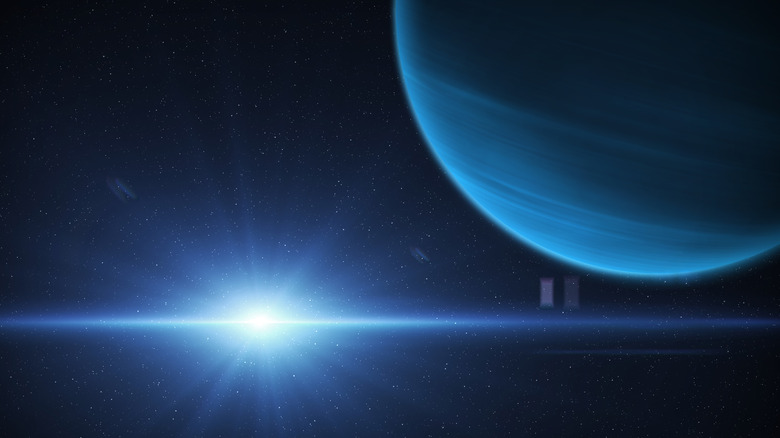Here's How Many Years It Would Take To Travel To Neptune
Neptune is a bit of a mystery. Now that Pluto has been downgraded to a dwarf planet (a planetary object that's not quite a planet), Neptune is the farthest planet from the sun. The gas giant is so far away, in fact, that it takes over four hours for sunlight to reach it, whereas it only takes eight minutes for sunlight to reach Earth, according to PBS.
Neptune is also a huge planet, almost four times larger than Earth, and not a very human-friendly one. For starters, it's a bit windy — while the strongest winds on Earth reach about 250 mph, winds on Neptune can reach speeds of up to 1,200 mph. These aren't your regular winds either — they're basically frozen gusts of hydrogen, helium, and methane (via NASA). Not a great combination if you're hoping to stay alive.
On top of that, it's also cold in Neptune: The temperature ranges from between minus 240 and 330 degrees Fahrenheit (per Weather). Neptune's atmosphere is made up of gas clouds followed by ice followed by more gases. This means if you were to step on Neptune, you would simply sink through it until, eventually, you reached the relatively small core of the planet, which is reported to be similar in size to that of Earth's — made up of a silicate-based rock and iron (per Universe Today). In other words, there's simply no way Neptune could sustain human life, or even sustain a short visit from a couple of astronauts.
What we've visited so far
We've been in love with the idea of space travel for a long, long time. But, despite our fascination with the stars since the beginning of the space age, we've only managed to reach two planets so far: Mars and Venus. To be fair, we've also landed on the moon and on Titan, the largest of Saturn's moons (via Universe Today). Titan is a significant addition to the list because it's the most remote of all four landings so far (per Open Mind BBVA).
We've only been to Titan once so far and for a short time. The Huygens probe landed on it in 2005 and transmitted data and photos for 90 minutes before it stopped working. NASA is hoping to send a drone to Titan in 2026, so we'll just have to wait for more.
While Mars might be the more famous planet, we've sent plenty of probes to Venus too, with the first one landing in 1962. With current technology, it would take 15 months for a spacecraft to reach Venus and 11 months for it to reach Mars (via Planetary Science Institute). That doesn't sound too bad, though there are plenty of challenges when it comes to keeping astronauts that long in space.
Traveling to Neptune
Things get a bit more complicated the farther away from Earth you move. Since Neptune isn't exactly landing-friendly, the best scientists can do is fly close to it and observe from a distance. But, even that isn't that easy. Neptune is about 4.3 billion kilometers away from Earth, compared to just 225 million kilometers to reach Mars.
When you convert that to time, you end up with a very, very long space trip. NASA's space probe Voyager 2 left Earth in 1977 in an effort to reach the far-away planets and gather information. Twelve years later, in 1989, Voyager 2 flew close enough to Neptune to take some breathtaking photos of the blue planet.
It's unlikely a manned spacecraft will ever fly all the way to Neptune. Aside from the fact that they couldn't land on it, there's also the issue with distance. It would likely take a spacecraft carrying astronauts longer than 12 years to reach the blue planet, and there's currently no technology available to allow humans to survive that long in space. According to Tomorrow Biostasis, the answer to long-distance space travel would be cryogenic sleep, a form of super-advanced hibernation.
Do we want to go to Neptune?
Neptune is a bit of a mystery even to astronomers. According to NASA, it's the only planet not visible to the naked eye. This gas giant is so far away and with such a unique atmosphere, it has fascinated both scientists and Hollywood for a very long time. Both "Star Trek," and the horror film "Event Horizon," where a ship disappears when orbiting near Neptune, mention the watery planet.
There's a reason the planet Neptune is so fascinating. According to The Planetary Society, ice planets like Neptune abound in the Universe, so understanding our neighbor could provide information to help scientists understand the universe better. And, while Neptune itself couldn't sustain human life, one of its moons (Triton) could potentially hold water and offer a world of opportunities.
While it's unlikely manned space travel will reach Neptune in the near future, there are two space missions in preparation that include Neptune in their itinerary. The first one is being organized by China and it would follow a similar trajectory to the Voyager 2, flying close to Neptune before continuing on. The second one, by NASA and called TRIDENT, would actually fly by Triton in hopes of identifying a subsurface ocean.



